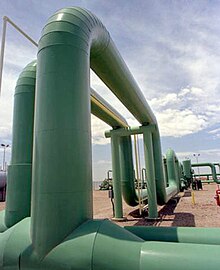
Back بنية تحتية هيدروجينية Arabic Infraestructura d'hidrogen Catalan Infraestructura de hidrógeno Spanish فراسازه هیدروژن Persian Infrastructure hydrogène French Hydrogeninfrastruktur NB Infrastructura economiei hidrogenului Romanian 氫氣基礎設施 Chinese

A hydrogen infrastructure is the infrastructure of hydrogen pipeline transport, points of hydrogen production and hydrogen stations for distribution as well as the sale of hydrogen fuel,[1] and thus a crucial prerequisite before a successful commercialization of fuel cell technology.[2]

The hydrogen infrastructure would consist mainly of industrial hydrogen pipeline transport and hydrogen-equipped filling stations. Hydrogen stations which were not situated near a hydrogen pipeline would get supply via hydrogen tanks, compressed hydrogen tube trailers, liquid hydrogen trailers, liquid hydrogen tank trucks or dedicated onsite production.
Pipelines are the cheapest way to move hydrogen over long distances compared to other options. Hydrogen gas piping is routine in large oil-refineries, because hydrogen is used to hydrocrack fuels from crude oil. The IEA recommends existing industrial ports be used for production and existing natural gas pipelines for transport: also international co-operation and shipping.[3]
South Korea and Japan,[4] which as of 2019 lack international electrical interconnectors, are investing in the hydrogen economy.[5] In March 2020, the Fukushima Hydrogen Energy Research Field was opened in Japan, claiming to be the world's largest hydrogen production facility.[6] Much of the site is occupied by a solar array; power from the grid is also used for electrolysis of water to produce hydrogen fuel.[7]
- ^ "Hydrogen infrastructure project launches in USA". 14 May 2013.
- ^ Eberle, Ulrich; Mueller, Bernd; von Helmolt, Rittmar. "Fuel cell electric vehicles and hydrogen infrastructure: status 2012". Energy & Environmental Science. Retrieved 23 December 2014.
- ^ IEA H2 2019, p. 15
- ^ "Japan's Hydrogen Strategy and Its Economic and Geopolitical Implications". Etudes de l'Ifri. Archived from the original on 10 February 2019. Retrieved 9 February 2019.
- ^ "South Korea's Hydrogen Economy Ambitions". The Diplomat. Archived from the original on 9 February 2019. Retrieved 9 February 2019.
- ^ "The world's largest-class hydrogen production, Fukushima Hydrogen Energy Research Field (FH2R) now is completed at Namie town in Fukushima". Toshiba Energy Press Releases. Toshiba Energy Systems and Solutions Corporations. 7 March 2020. Archived from the original on 22 April 2020. Retrieved 1 April 2020.
- ^ Patel, Sonal (1 July 2022). "Fukushima Hydrogen Energy Research Field Demonstrates Hydrogen Integration". POWER Magazine. Retrieved 5 October 2023.